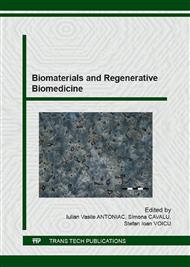[1]
S. Aydin, B. Kucukyuruk, B. Abuzayed, S. Aydin, G.Z. Sanus, Cranioplasty: Review of materials and techniques, J Neurosci Rural Pract., 2 (2011) 162–167.
DOI: 10.4103/0976-3147.83584
Google Scholar
[2]
N. Basheer, D. Gupta, A, K, Mahapatra, H. Gurjar, Cranioplasty following decompressive craniotomy in traumatic brain injury: Experience at Level - I apex trauma centre, Indian Journal of Neurotrauma (IJNT), 7 (2010) 139-144.
DOI: 10.1016/s0973-0508(10)80029-2
Google Scholar
[3]
Z.Y. Ng, I. Nawaz, Computer-designed PEEK implants: a peek into the future of cranioplasty?, J Craniofac Surg., 25 (2014) 55-58.
DOI: 10.1097/scs.0b013e3182a2f7b6
Google Scholar
[4]
A. Tasiou, K. Vagkopoulos, I. Georgiadis, A.G. Brotis, H. Gatos, K.N. Fountas, Cranioplasty optimal timing in cases of decompressive craniotomy after severe head injury: a systematic literature review, Interdisciplinary Neurosurgery, 1 (2014).
DOI: 10.1016/j.inat.2014.06.005
Google Scholar
[5]
E.B. O'Reilly, S. Barnett, C. Madden, B. Weich, B. Mickey, S. Rozen, Computed-tomography modeled polyether ether ketone (PEEK) implants in revision cranioplasty, J Plast Reconstr Aesthet Surg. 68 (2015) 329-338.
DOI: 10.1016/j.bjps.2014.11.001
Google Scholar
[6]
B. J. Kim, K.S. Hong, K.J. Park, D.H. Park, Y.G. Chung, S.H. Kang, Customized Cranioplasty Implants Using Three-Dimensional Printers and Polymethyl-Methacrylate Casting, J Korean Neurosurg Soc. 52 (2012) 541–546.
DOI: 10.3340/jkns.2012.52.6.541
Google Scholar
[7]
J. Vekatesan, S.K. Kim, Chitosan Composites fore bone tissue engineering – an overview, Mar Drugs, 8 (2010) 2252-2266.
Google Scholar
[8]
I.C. Stancu, D.M. Dragusin, E. Vasile, R. Trusca, I. Antoniac, D.S. Vasilescu, Porous calcium alginate-gelatin interpenetrated matrix and its biomineralization potential, JMS: MM, 22 (2011) 451-460.
DOI: 10.1007/s10856-011-4233-7
Google Scholar
[9]
M.D. Vranceanu, I. Antoniac, F. Miculescu, R. Saban, The influence of the ceramic phase on the porosity of some biocomposites with collagen matrix used as bone substitutes, JOAM, 14 (2012) 671–677.
Google Scholar
[10]
I. Antoniac, M.D. Vranceanu, A. Antoniac, The influence of the magnesium powder used as reinforcement material on the properties of some collagen based composite biomaterials, JOAM 15 (2013) 667-672.
Google Scholar
[11]
J. Rau, I.V. Antoniac, G. Cama, V. Komlev, A. Ravaglioli, Bioactive Materials for Bone Tissue Engineering, Biomed Research International, article ID 3741428 (2016) 3 pages.
DOI: 10.1155/2016/3741428
Google Scholar
[12]
R. Marinescu, I.V. Antoniac, D. Laptoiu, A. Antoniac, D. Grecu, Complications related to Biocomposite Screw Fixation in ACL Reconstruction Based on Clinical Experience and Retrieval Analysis, Materiale Plastice 52 (2015) 340-344.
DOI: 10.1007/978-3-319-09230-0_43-1
Google Scholar
[13]
T. Petreus, B.A. Stoica, O. Petreus, A. Goriuc, C.E. Cotrutz, I.V. Antoniac, L. Barbu-Tudoran, Preparation and cytocompatibility evaluation for hydrosoluble phosphorous acid-derivatized cellulose as tissue engineering scaffold material, JMS-MM, 25 (2014).
DOI: 10.1007/s10856-014-5146-z
Google Scholar
[14]
E. Battistella, S. Mele, I. Foltran, I.G. Lesci, N. Roveri, P. Sabatino, L. Rimondini, Cuttlefish bone scaffold for tissue engineering: a novel hydrothermal transformation, chemical-physical, and biological characterization, Journal of Applied Biomaterials and Fundamental Materials, 10 (2012).
DOI: 10.5301/jabfm.2012.9257
Google Scholar


